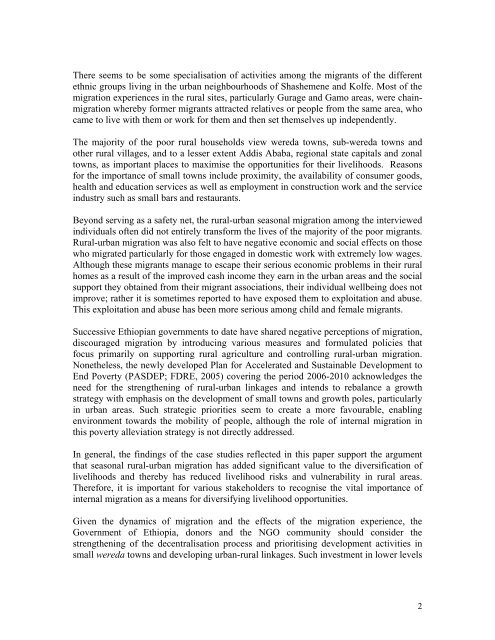Migration and Rural-Urban Linkages in Ethiopia
Migration and Rural-Urban Linkages in Ethiopia - Ethiopian Review
Migration and Rural-Urban Linkages in Ethiopia - Ethiopian Review
Create successful ePaper yourself
Turn your PDF publications into a flip-book with our unique Google optimized e-Paper software.
There seems to be some specialisation of activities among the migrants of the differentethnic groups liv<strong>in</strong>g <strong>in</strong> the urban neighbourhoods of Shashemene <strong>and</strong> Kolfe. Most of themigration experiences <strong>in</strong> the rural sites, particularly Gurage <strong>and</strong> Gamo areas, were cha<strong>in</strong>migrationwhereby former migrants attracted relatives or people from the same area, whocame to live with them or work for them <strong>and</strong> then set themselves up <strong>in</strong>dependently.The majority of the poor rural households view wereda towns, sub-wereda towns <strong>and</strong>other rural villages, <strong>and</strong> to a lesser extent Addis Ababa, regional state capitals <strong>and</strong> zonaltowns, as important places to maximise the opportunities for their livelihoods. Reasonsfor the importance of small towns <strong>in</strong>clude proximity, the availability of consumer goods,health <strong>and</strong> education services as well as employment <strong>in</strong> construction work <strong>and</strong> the service<strong>in</strong>dustry such as small bars <strong>and</strong> restaurants.Beyond serv<strong>in</strong>g as a safety net, the rural-urban seasonal migration among the <strong>in</strong>terviewed<strong>in</strong>dividuals often did not entirely transform the lives of the majority of the poor migrants.<strong>Rural</strong>-urban migration was also felt to have negative economic <strong>and</strong> social effects on thosewho migrated particularly for those engaged <strong>in</strong> domestic work with extremely low wages.Although these migrants manage to escape their serious economic problems <strong>in</strong> their ruralhomes as a result of the improved cash <strong>in</strong>come they earn <strong>in</strong> the urban areas <strong>and</strong> the socialsupport they obta<strong>in</strong>ed from their migrant associations, their <strong>in</strong>dividual wellbe<strong>in</strong>g does notimprove; rather it is sometimes reported to have exposed them to exploitation <strong>and</strong> abuse.This exploitation <strong>and</strong> abuse has been more serious among child <strong>and</strong> female migrants.Successive <strong>Ethiopia</strong>n governments to date have shared negative perceptions of migration,discouraged migration by <strong>in</strong>troduc<strong>in</strong>g various measures <strong>and</strong> formulated policies thatfocus primarily on support<strong>in</strong>g rural agriculture <strong>and</strong> controll<strong>in</strong>g rural-urban migration.Nonetheless, the newly developed Plan for Accelerated <strong>and</strong> Susta<strong>in</strong>able Development toEnd Poverty (PASDEP; FDRE, 2005) cover<strong>in</strong>g the period 2006-2010 acknowledges theneed for the strengthen<strong>in</strong>g of rural-urban l<strong>in</strong>kages <strong>and</strong> <strong>in</strong>tends to rebalance a growthstrategy with emphasis on the development of small towns <strong>and</strong> growth poles, particularly<strong>in</strong> urban areas. Such strategic priorities seem to create a more favourable, enabl<strong>in</strong>genvironment towards the mobility of people, although the role of <strong>in</strong>ternal migration <strong>in</strong>this poverty alleviation strategy is not directly addressed.In general, the f<strong>in</strong>d<strong>in</strong>gs of the case studies reflected <strong>in</strong> this paper support the argumentthat seasonal rural-urban migration has added significant value to the diversification oflivelihoods <strong>and</strong> thereby has reduced livelihood risks <strong>and</strong> vulnerability <strong>in</strong> rural areas.Therefore, it is important for various stakeholders to recognise the vital importance of<strong>in</strong>ternal migration as a means for diversify<strong>in</strong>g livelihood opportunities.Given the dynamics of migration <strong>and</strong> the effects of the migration experience, theGovernment of <strong>Ethiopia</strong>, donors <strong>and</strong> the NGO community should consider thestrengthen<strong>in</strong>g of the decentralisation process <strong>and</strong> prioritis<strong>in</strong>g development activities <strong>in</strong>small wereda towns <strong>and</strong> develop<strong>in</strong>g urban-rural l<strong>in</strong>kages. Such <strong>in</strong>vestment <strong>in</strong> lower levels2




![to read the full report [pdf, Amharic] - Ethiopian Review](https://img.yumpu.com/52737829/1/190x245/to-read-the-full-report-pdf-amharic-ethiopian-review.jpg?quality=85)











